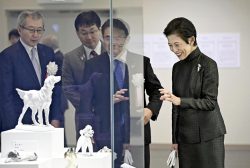
Part of “Beauties at a Flourishing Brothel” by Katsushika Hokusai, Katsukawa Shunei, Utagawa Toyokuni, Katsukawa Shunsen, Katsukawa Shunshu and Katsukawa Shunko (on view through Sunday)
19:04 JST, March 2, 2021
Ukiyo-e in the Edo period (1603-1867) is often associated with mass-produced woodblock prints, but many artists at that time also created paintings.
Such original works, a number newly discovered, by Katsushika Hokusai and his peers are featured in an exhibition currently underway at the Sumida Hokusai Museum in Sumida Ward, Tokyo, which delves into the transition of styles over the years.
Titled “The Soul of the Brush — the Line’s Pull, the Color’s Spell, From Matabei to Hokusai and Kuniyoshi,” the exhibition showcases about 125 paintings spanning from the first half of the 17th century to the end of the Edo period. About 40 are either newly discovered or rediscovered, some on exhibit for the first time.
The show consists of a first term, underway through Sunday, and a second term from March 9 through April 4. Almost all works on display will be different in each term.
The three-section exhibition begins with works by Iwasa Matabei, an artist known for genre paintings in the early modern period, and continues with paintings by acclaimed ukiyo-e pioneer Hishikawa Moronobu and a variety from the Kaigetsudo, Miyagawa, Torii and Katsukawa schools.
Also on display are works by Nishikawa Sukenobu and other painters who were active in the Kamigata region (in present-day Osaka and Kyoto), as well as Kitagawa Utamaro, a master painter of bijin-ga portraits of beautiful women.
The show also introduces visitors to the various themes, such as actors, animals and plants, used by the Utagawa and Katsushika schools that were equally popular from the latter half of the 18th century to the end of the Edo period.

Left screen of “Nine Variations of Nakamura Utaemon III” by Utagawa Toyokuni (on view through Sunday)
An unlikely collaboration
The highlight of the exhibition is “Beauties at a Flourishing Brothel,” a newly confirmed work dated from the early 19th century, when Hokusai would have been around 50 years old, that was a collaboration of six artists.
In addition to Hokusai, Katsukawa Shunko and three others from the Katsukawa school to which Hokusai belonged when he was younger, and Utagawa Toyokuni, Hokusai’s main rival for popularity at the time, jointly worked on the painting, which depicts brothel workers in vivid colors and is an excellent example of back-coloring.
According to a biography of Hokusai written during the Meiji era (1868-1912), he did not get along with Shunko, who had been senior to him during their time at the Katsukawa school. This was said to be a reason behind his departing the school to become independent.
However, Keio University Prof. Masato Naito, an expert in Japanese art history who curated the exhibition, said the newly discovered collaboration raises questions about the theory that there was a bad relationship between the two artists.
In the project, Hokusai’s job was to draw the foremost lady, who is the owner of the brothel, while Shunko was tasked with the jester in the far back. The right-handed Shunko had been partially paralyzed and had to use his left hand — his signature, reading “Shunko, drawn with left hand,” is slightly off kilter. Judging by the brushstroke, Naito believed Shunko worked on the painting shortly before his death in 1812.
So, why did the two artists allegedly not on good terms collaborate on a work?
According to Naito, Hokusai was the first to paint, while Shunko, the oldest member of the group, was the last. Allowing Shunko to paint last was a sign of respect. Adding in the fact that two of Shunko’s proteges also took part leads Naito to believe that Hokusai did not completely cut his ties with Shunko and the Katsukawa school.
“It is only natural to imagine there was some sort of special opportunity involving the aging Shunko,” Naito said. “Even after Hokusai became independent from the Katsukawa school, he likely maintained a relationship with the senior members.”
Among the newly discovered works is Utagawa Toyokuni’s “Nine Variations of Nakamura Utaemon III.” Toyokuni rhythmically depicts on eight panels a popular kabuki actor of the time performing in different costumes. The artist added Ota Nambo’s songs of the four seasons as the end panels on both the left and right sides.
According to Naito, the work was handed down to an official painter belonging to the Satake clan of the Akita domain. It stirs up curiosity as to why such a lavish screen painting depicting a popular actor ended up in the hands of a court painter close to a feudal lord.
Subtle differences
With bijin-ga portraits of beautiful women as the mainstream, ukiyo-e artists tried their hands at a variety of expressions.
“Ukiyo-e paintings were fundamentally bijin-ga, and only later would popular genres of the times, such as actors, also become subjects of art,” said Naito. “Artists would show individuality through different facial expressions and, toward the end of the Edo period, tastes in themes of paintings started diversifying.”
The lines that cannot be seen in woodblock prints or printed books show subtle differences in paintings. Ukiyo-e artists greatly contributed to the popular culture of the time, and their passion comes through in their original paintings.
"Culture" POPULAR ARTICLE
-

Van Cleef & Arpels Dazzles with Art Deco Artisanry at Tokyo Exhibit
-

Disney’s ‘Twisted-Wonderland’ Animated Series Puts Villains in Spotlight: New Show Features School Inspired by Classic Disney Films
-

Japan Plans to Distribute Manga Overseas Via New Platform
-

Japanese Craftsman Produces Beautiful and Durable Bags Made of Wood
-

Ayumi Hamasaki’s Shanghai Concert Canceled Day Before Schedule as Part of Beijing Backlash
JN ACCESS RANKING
-

Keidanren Chairman Yoshinobu Tsutsui Visits Kashiwazaki-Kariwa Nuclear Power Plant; Inspects New Emergency Safety System
-

Imports of Rare Earths from China Facing Delays, May Be Caused by Deterioration of Japan-China Relations
-

Japan Pulls out of Vietnam Nuclear Project, Complicating Hanoi’s Power Plans
-

Govt Aims to Expand NISA Program Lineup, Abolish Age Restriction
-

Blanket Eel Trade Restrictions Rejected

























